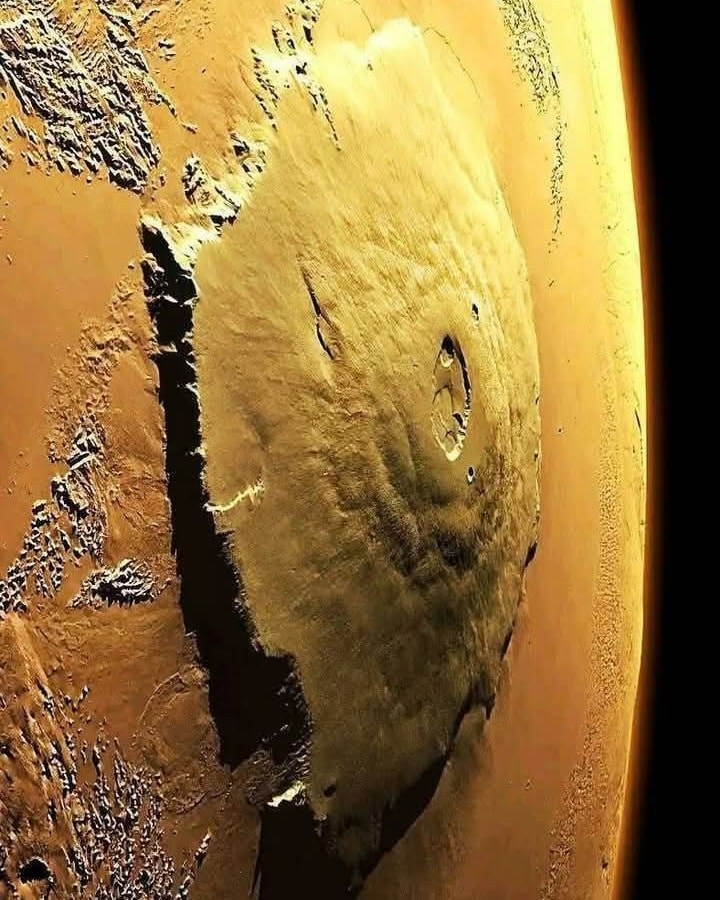When we think about space exploration, distant galaxies and alien worlds often capture our imagination. However, one of the most incredible and awe-inspiring natural wonders in our solar system is right in our cosmic backyard: Olympus Mons, the towering Martian volcano that dwarfs every mountain on Earth.
A Mountain of Gigantic Proportions
At about 25 kilometers (15.5 miles) high—almost three times the height of Mount Everest—and a base spanning 600 kilometers (373 miles), Olympus Mons is a geological marvel. Its sheer size makes it a planetary monument, more colossal than most features found on Earth. To put it into perspective, Olympus Mons’ size rivals that of entire countries, making it one of the largest known volcanoes in the solar system.
How Olympus Mons Formed
The incredible size of Olympus Mons is due to a combination of unique Martian conditions:
- No Tectonic Plates: Unlike Earth, Mars does not have moving tectonic plates. Lava erupts from the same spot for millions of years, allowing the volcano to grow without disruption.
- Low Gravity: With gravity only one-third of Earth’s, Mars can support such enormous mountains without them collapsing under their own weight.
- Thin Atmosphere: Mars’ thin atmosphere means little weathering and erosion, allowing Olympus Mons to remain strikingly preserved over time.
Scientists believe that Olympus Mons began to form more than 200 million years ago, and it may have erupted as recently as a few million years ago—a geologically recent event.
Mysteries of the Martian Giant
Despite decades of study, there are still many unknowns about Olympus Mons:
- Towering Cliffs: The edges of the volcano feature scarps—cliffs up to 6 kilometers (3.7 miles) high—likely formed by landslides or lava interacting with subsurface ice.
- Enormous Summit Caldera: The summit of Olympus Mons hosts a volcanic crater that spans 80 kilometers (50 miles). This complex crater includes multiple collapse craters from massive eruptions.
- Signs of Water: Orbital imagery reveals potential signs of lava interacting with underground ice, possibly creating steam vents or temporary lakes during past eruptions.
These mysteries add to the volcano’s intrigue and continue to inspire further research on Mars’ geological history.
A Gateway for Future Exploration
Olympus Mons is more than just a scientific curiosity—it could play a crucial role in future missions to Mars. The volcanic lava tubes and underground tunnels could offer natural shelters for astronauts, protecting them from cosmic radiation and harsh dust storms. Studying Olympus Mons also provides key insights into planetary volcanism, helping scientists understand how other worlds, like Venus or Jupiter’s moon Io, may have evolved.
How It Compares to Everest
For a sense of scale, imagine placing Olympus Mons on Earth. Its summit would reach far into the stratosphere, far surpassing Mount Everest’s 8.8 kilometers (5.5 miles). The scale of Olympus Mons highlights the stark differences between planets in our solar system, emphasizing the vastness and diversity of planetary features.
A Silent Symbol of Mars’ Grandeur
Olympus Mons is not just the largest volcano in the solar system—it’s a silent testament to Mars’ dramatic geological history and humanity’s expanding ambitions to explore the cosmos. As new images are captured by orbiters and rovers, our fascination with this majestic Martian giant only grows.
One day, explorers may stand at its base, transforming science fiction into reality.



